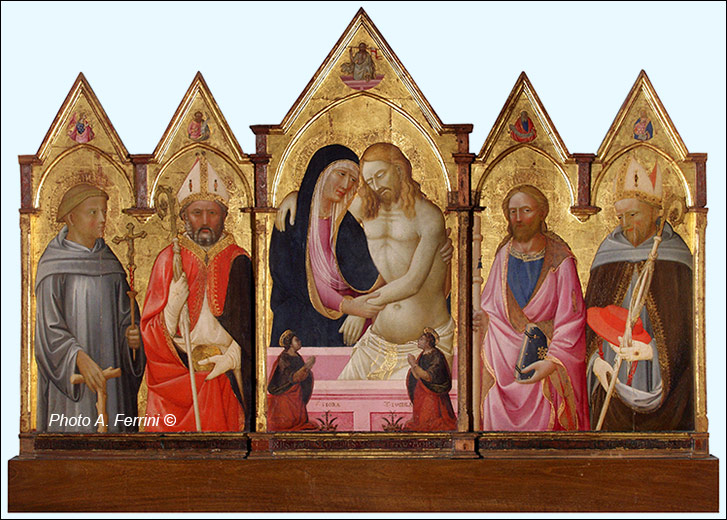Carda
in Casentino, una bella valle Toscana che puoi conoscere in ogni suo dettaglio con questo sito
Italiano
SANTI VALLOMBROSANI A CARDA
Chiesa delle Sante Flora e Lucilla a Carda, Castel Focognano.
"Cristo in Pietà e Santi". Polittico di Mariotto di Cristofano databile 1425/26.
Come la Madonna con Bambino di Santi Buglioni, anche quest'opera non fu realizzata per Carda, ma arrivò qui in modo abbastanza casuale. Nel 1425 i monaci della vicina Badia di Santa Trinità in Alpe chiesero che la loro abbazia fosse annessa a Vallombrosa, un'abbazia sorta sulle pendici nord del Pratomagno nel 1050/60. I monaci vallombrosani tenevano molto a Santa Trinita, così, per valorizzarla, commissionarono al pittore valdarnese Mariotto di Cristofano questo dipinto su fondo oro che oggi possiamo ammirare a Carda. L'artista, che si esprimeva in uno stile tardo gotico era conosciuto e apprezzato in Valdarno e anche a Firenze. Inoltre è stimato dai monaci vallombrosani che gli avevano commissionato varie opere. Probabilmente Mariotto acquisirà notorietà anche per essere cognato di Masaccio e forse di essere stato il suo primo maestro visto aveva otto anni di più e si trovava nello stesso ambito familiare.
In questo dipinto Gesù e la Vergine sono accompagnati da quattro Santi. Da sinistra abbiamo San Giovanni Gualberto, Nicola di Bari, Jacopo Maggiore e Bernardo degli Uberti. Il primo e l'ultimo, certamente voluti dai vallombrosani, sono grandi figure di quest'ordine. Giovanni Gualberto ne fu il fondatore, Bernardo degli Uberti (Firenze 1060 circa, Parma 1133) fu Abate Generale di Vallombrosa, Cardinale e Vescovo di Parma dal 1106 fino alla morte. L'opera, con queste due grandi figure, era una sorta di attestato di proprietà di Vallombrosa su Santa Trinita.
Quando nella seconda metà del XVI secolo Badia Santa Trinita inizia la sua decadenza strutturale, anche perché a Vallombrosa questo luogo non interessava più tanto, il polittico fu traferito nella Chiesa di Carda. È l'anno 1570 come ricorda una lapide posta in questa chiesa e che vedremo tra qualche pagina. La lapide ci dice inoltre che il dipinto "di fattura in legno" trovò posto sopra la porta della sacrestia.
Come i Vallombrosani posero la loro firma sul dipinto inserendo due loro santi, gli abitanti di Carda non vollero essere da meno. Aggiunsero le due piccole figure in basso, nella parte centrale dell'opera. Sono le Sante Flora e Lucille, patrone di Carda.
Church of Saints Flora and Lucilla in Carda, Castel Focognano.
"Christ in Pietà and Saints". Polyptych by Mariotto di Cristofano datable to 1425/26.
Like the Madonna with Child by Santi Buglioni, this work was not made for Carda, but arrived here quite by chance. In 1425 the monks of the nearby Badia di Santa Trinità in Alpe asked that their abbey be annexed to Vallombrosa, an abbey built on the northern slopes of Pratomagno in 1050/60. The Vallombrosan monks were very fond of Santa Trinita, so, to enhance it, they commissioned the Valdarno painter Mariotto di Cristofano to create this painting on a gold background that we can admire today in Carda. The artist, who expressed himself in a late Gothic style, was known and appreciated in Valdarno and also in Florence. He is also esteemed by the Vallombrosan monks who had commissioned various works from him. Mariotto probably also acquired notoriety for being Masaccio's brother-in-law and perhaps for having been his first teacher, given that he was eight years older and lived in the same family environment.
In this painting, Jesus and the Virgin are accompanied by four Saints. From the left we have Saint Giovanni Gualberto, Nicholas of Bari, Jacopo Maggiore and Bernardo degli Uberti. The first and the last, certainly desired by the Vallombrosans, are great figures of this order. Giovanni Gualberto was its founder, Bernardo degli Uberti (Florence around 1060, Parma 1133) was Abbot General of Vallombrosa, Cardinal and Bishop of Parma from 1106 until his death. The work, with these two great figures, was a sort of certificate of ownership of Vallombrosa on Santa Trinita.
When in the second half of the 16th century Badia Santa Trinita began its structural decline, also because Vallombrosa was no longer interested in this place, the polyptych was transferred to the Church of Carda. It is the year 1570 as a plaque placed in this church and which we will see in a few pages recalls. The plaque also tells us that the painting "made of wood" was placed above the door of the sacristy.
As the Vallombrosans put their signature on the painting by inserting two of their saints, the inhabitants of Carda did not want to be outdone. They added the two small figures at the bottom, in the central part of the work. They are Saints Flora and Lucille, patron saints of Carda.

















































